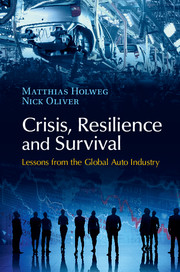Book contents
- Frontmatter
- Dedication
- Contents
- List of figures
- List of tables
- Acknowledgements
- 1 Why a book on corporate resilience?
- 2 The evolution of a global industry
- 3 Competing in a global industry
- 4 Concepts: Stakeholders, operations and context
- 5 Rover: Inside a failing car company
- 6 The failure of Saab Automobile
- 7 Near misses: Chrysler and Nissan
- 8 The future shape of the industry
- Appendix
- Notes
- Bibliography
- Secondary data sources
- Index
7 - Near misses: Chrysler and Nissan
Published online by Cambridge University Press: 05 December 2015
- Frontmatter
- Dedication
- Contents
- List of figures
- List of tables
- Acknowledgements
- 1 Why a book on corporate resilience?
- 2 The evolution of a global industry
- 3 Competing in a global industry
- 4 Concepts: Stakeholders, operations and context
- 5 Rover: Inside a failing car company
- 6 The failure of Saab Automobile
- 7 Near misses: Chrysler and Nissan
- 8 The future shape of the industry
- Appendix
- Notes
- Bibliography
- Secondary data sources
- Index
Summary
In Chapters 5 and 6 we examined the failures of Rover and Saab, the two most significant car companies to fail within the last decade or so. However, equally significant to any understanding of resilience in the auto industry are the cases of those companies that experienced crisis but managed to survive. Indeed, in more or less every decade since the Second World War there are examples of car companies that experienced a significant crisis and that managed to survive. In this chapter we examine two examples of ‘near death’ experiences, Japan's Nissan (in 1999) and Chrysler in the USA (in 1979 and again in 2009).
Many car firms that are currently regarded as strong, industry leading enterprises have – at least once in their lifetimes – come close to collapse. Crises are a perennial feature of the motor industry and have afflicted auto companies across all regions of the globe. Toyota, for example, nearly failed in 1950. In the early 1950s the young Toyota Motor Company faced a serious drop in demand as credit from the Reconstruction Finance Bank was restricted and a recession hit the Japanese market at the same time. Toyota vowed to honour its life-time employment contracts, but in the end had to lay off 2,146 workers through voluntary redundancy. The crisis forced company founder Kiichiro Toyoda to resign as president, after issuing a profuse apology to its workforce, and led to the division of Toyota's manufacturing and sales arms into two companies, a division which remained until 1982. Toyota's President Akio Toyoda summed up the nature of the industry, stating that ‘Toyota has been hit by a crisis about once every ten years.’ This picture replicates itself at most major car firms: VW, for example, one of the largest car makers in the world at the time of writing, experienced existential crises in 1973–4, 1982–3 and 1992–4, made a €1bn loss in the US market in 2004, and announced a $5bn cost reduction programme in 2014.
In this chapter we describe two companies that have faced crises that led them to near-bankruptcy, but which survived: Chrysler, which has experienced a number of crises, but which was bailed out by the US Government in 1979 and 2009; and Nissan, which came close to bankruptcy in 1999 and was saved by entering an alliance with France's Renault.
- Type
- Chapter
- Information
- Crisis, Resilience and SurvivalLessons from the Global Auto Industry, pp. 219 - 258Publisher: Cambridge University PressPrint publication year: 2015



